Applying Systems Thinking Concepts to Major Casualty Fires: Lessons Learned from Taiwan
Abstract
:1. Introduction
1.1. The Cheng Chung Cheng Building Fire Disaster
1.1.1. Background of the Cheng Chung Cheng Building
1.1.2. Cause of the Fire
1.1.3. Details of the Investigation Report
- ➢
- Negligence with unextinguished agarwood: The initial cause of the fire was the careless handling of unextinguished agarwood, which was used as a mosquito repellent. The individual responsible left the building without extinguishing the agarwood, igniting nearby flammable materials.
- ➢
- Inadequate Maintenance of Fire Safety Equipment: The building’s fragmented ownership led to non-compliance with legal standards for using and maintaining fire safety equipment, specifically failing to adhere to Article 9 of Taiwan’s Fire Service Act.
- ➢
- Deficient Management Organization: The building lacked a proper management organization for overseeing fire safety, with existing functions limited to maintaining cleanliness, neglecting necessary fire safety prevention, preparedness, and emergency response as required under the Condominium Administration Act.
- ➢
- Need for Regulatory Amendments: The investigation highlighted gaps in the Fire Service Act, particularly Article 9, which does not require maintenance declarations for fire equipment in vacant areas of composite buildings; and Article 37, which does not ensure timely fire safety inspections in buildings without a management committee.
- ➢
- Oversight by Authority with Jurisdictions: The complexity of property rights within the building hindered adequate fire safety inspections. Fire inspectors did not engage with public works or police to address these challenges, and the Public Works Bureau in Kaohsiung has not promoted public safety in smaller buildings nor facilitated necessary inter-agency coordination with the fire department.
1.2. Literature Review
2. Methodology and Materials
2.1. System Dynamics and System Thinking
2.1.1. Reinforcing Causal Loops
2.1.2. Balancing Causal Loops
2.1.3. Time Delays
2.2. Critical Factors
3. Results and Discussion
3.1. Systems Thinking Model
3.2. Residents’ Characteristics Subsystem
3.3. Building-Related Subsystem
3.4. Fire Situation
3.5. Combined System
3.6. Recommendations
- Resident-Level Interventions:
- Targeted risk communication campaigns: Develop customized fire prevention education for socioeconomically vulnerable groups (e.g., people who are elderly, on a low-income, or use substances) using accessible media formats (e.g., community radio, social media, local dialects, and home visits).
- Regular health and mental state screenings in aging or public housing communities to identify and support residents with limited judgment capacity or physical mobility, particularly those living alone.
- Community-based hoarding intervention teams, coordinated through public health and housing departments, to reduce excessive fire loads in residential units.
- Building-Level Interventions:
- Mandate periodic audits of compartmentation, smoke extraction systems, and escape route signage in mixed-use and aging high-rise buildings. The results should be made publicly accessible to promote transparency and accountability.
- Subsidize fire safety retrofits (e.g., fire doors, automatic smoke vents, pressurized stairwells, alarm systems) through a government-led incentive scheme targeted at low-income or collectively owned buildings.
- Incentivize the establishment of active management committees under the Condominium Administration Act, with legal responsibilities for fire safety maintenance, emergency drills, and equipment upkeep.
- Emergency Response and Coordination:
- Integrate stay-or-evacuate decision trees into 119 command center systems using building-specific data (e.g., sprinkler status, fire load level), supported by AI-based decision support tools.
- Formalize dispatcher–resident interaction protocols, ensuring early and accurate guidance. Lessons from cases like the Grenfell Tower fire should inform protocols.
- Conduct inter-agency scenario drills, including dispatchers, firefighters, and community leaders, simulating high-casualty fire incidents in dense residential environments.
- Cross-System Monitoring and Data Transparency:
- Establish a centralized high-rise fire risk registry, integrating building characteristics, incident history, inspection records, and resident vulnerability indices. This can guide resource allocation and emergency preparedness.
- Require post-incident data-sharing protocols among fire departments, urban planning authorities, and academic institutions to enable feedback-driven policy adjustment and modeling to refine recommendations that aim to address the direct symptoms of fire-related issues and intervene at systemic issue points identified through our model. This way, more resilient fire safety ecosystem can be developed by bridging individual behavior, infrastructure quality, and institutional responses.
4. Conclusions
Author Contributions
Funding
Institutional Review Board Statement
Informed Consent Statement
Data Availability Statement
Acknowledgments
Conflicts of Interest
Abbreviations
| ASET | Available Safe Egress Time |
| RSET | Required Safe Egress Time |
References
- Everington, K. 46 Dead, 41 Injured After Kaohsiung ‘Ghost Building’ Fire. Taiwan News. 14 October 2021. Available online: https://archive.ph/20211014104229/https://www.taiwannews.com.tw/en/news/4314525 (accessed on 31 December 2024).
- Fire Administrative Investigation Team. Investigation report on the fire incident at the Cheng Chung Cheng Building in Yancheng District, Kaohsiung City. 2022. Available online: https://ws.kcg.gov.tw/001/KcgUploadFiles/263/relfile/9460/71041/4ad8fe1c-05f5-4a75-9c0e-4cfef9e4f3e6.pdf (accessed on 31 December 2024).
- Xiong, L.; Bruck, D.; Ball, M. Comparative investigation of ‘survival’and fatality factors in accidental residential fires. Fire Saf. J. 2015, 73, 37–47. [Google Scholar] [CrossRef]
- Brennan, P. Victims and survivors in fatal residential building fires. Fire Mater. 1999, 23, 305–310. [Google Scholar] [CrossRef]
- Spearpoint, M.; Hopkin, C. A study of the time of day and room of fire origin for dwelling fires. Fire Technol. 2020, 56, 1465–1485. [Google Scholar] [CrossRef]
- Jonsson, A.; Runefors, M.; Gustavsson, J.; Nilson, F. Residential fire fatality typologies in Sweden: Results after 20 years of high-quality data. J. Saf. Res. 2022, 82, 68–84. [Google Scholar] [CrossRef] [PubMed]
- Chien, S.-W.; Wu, G.-Y. The strategies of fire prevention on residential fire in Taipei. Fire Saf. J. 2008, 43, 71–76. [Google Scholar] [CrossRef]
- Istre, G.R.; McCoy, M.A.; Moore, B.J.; Roper, C.; Stephens-Stidham, S.; Barnard, J.J.; Carlin, D.K.; Stowe, M.; Anderson, R.J. Preventing deaths and injuries from house fires: An outcome evaluation of a community-based smoke alarm installation programme. Inj. Prev. 2014, 20, 97–102. [Google Scholar] [CrossRef]
- Istre, G.R.; McCoy, M.A.; Osborn, L.; Barnard, J.J.; Bolton, A. Deaths and injuries from house fires. N. Engl. J. Med. 2001, 344, 1911–1916. [Google Scholar] [CrossRef]
- Sun, J.; Hu, L.; Zhang, Y. A review on research of fire dynamics in high-rise buildings. Theor. Appl. Mech. Lett. 2013, 3, 042001. [Google Scholar] [CrossRef]
- Li, G.-Q.; Zhang, C.; Jiang, J. A review on fire safety engineering: Key issues for high-rise buildings. Int. J. High-Rise Build. 2018, 7, 265–285. [Google Scholar]
- Rein, G.; Zhang, X.; Williams, P.; Hume, B.; Heise, A.; Jowsey, A.; Lane, B.; Torero, J.L. Multi-Story Fire Analysis for High-Rise Buildings. 2007. Available online: https://www.researchgate.net/publication/277237623_Multi-story_Fire_Analysis_for_High-Rise_Buildings. (accessed on 14 March 2025).
- Ronchi, E.; Nilsson, D. Fire evacuation in high-rise buildings: A review of human behaviour and modelling research. Fire Sci. Rev. 2013, 2, 1–21. [Google Scholar] [CrossRef]
- Arewa, A.O.; Ahmed, A.; Edwards, D.J.; Nwankwo, C. Fire safety in high-rise buildings: Is the stay-put tactic a misjudgement or magnificent strategy? Buildings 2021, 11, 339. [Google Scholar] [CrossRef]
- Hall, J.R. High-Rise Building Fires; The Association: Quincy, MA, USA, 2000. [Google Scholar]
- Larson, R.C.; Metzger, M.D.; Cahn, M.F. Responding to emergencies: Lessons learned and the need for analysis. Interfaces 2006, 36, 486–501. [Google Scholar] [CrossRef]
- Cooke, D.L. A system dynamics analysis of the Westray mine disaster. Syst. Dyn. Rev. J. Syst. Dyn. Soc. 2003, 19, 139–166. [Google Scholar] [CrossRef]
- Sterman, J.D. Business Dynamics: Systems Thinking and Modeling for a Complex World; McGraw-Hill Education: New York, NY, USA, 2002. [Google Scholar]
- Collins, R.D. Forest Fire Management in Portugal: Developing System Insights Through Models of Social and Physical Dynamics; Massachusetts Institute of Technology: MA, USA, 2012. [Google Scholar]
- Reason, J. Managing the Risks of Organizational Accidents; Routledge: London, UK, 2016. [Google Scholar]
- Senge, P.M. The Fifth Discipline: The Art and Practice of the Learning Organization; Broadway Business: New York, NY, USA, 2006. [Google Scholar]
- Goh, Y.M.; Brown, H.; Spickett, J. Applying systems thinking concepts in the analysis of major incidents and safety culture. Saf. Sci. 2010, 48, 302–309. [Google Scholar] [CrossRef]
- Lin, C.L.; Chien, C.F. Systems thinking in a gas explosion accident–lessons learned from Taiwan. J. Loss Prev. Process Ind. 2019, 62, 103987. [Google Scholar] [CrossRef]
- Goh, Y.M.; Love, P.E.; Lo, D. System Dynamics Analysis of Organizational Accidents: A Review of Current Approaches. In Proceedings of the 28th International Conference of The System Dynamics Society, Seoul, Republic of Korea, 25–29 July 2010. [Google Scholar]
- Bwalya, A.; Lougheed, G.; Kashef, A.; Saber, H. Survey results of combustible contents and floor areas in Canadian multi-family dwellings. Fire Technol. 2011, 47, 1121–1140. [Google Scholar] [CrossRef]
- Campbell, R.B. Fires in Residential Properties Under Construction or Undergoing Major Renovation; National Fire Protection Association. Fire Analysis and Research Division: MA, USA, 2014. [Google Scholar]
- Corman, H.; Ignall, E.J.; Rider, K.L.; Stevenson, A. Fire casualties and their relation to fire company response distance and demographic factors. Fire Technol. 1976, 12, 193–203. [Google Scholar] [CrossRef]
- Edwards, A.C.; Maier, S.W.; Hutley, L.B.; Williams, R.J.; Russell-Smith, J. Spectral analysis of fire severity in north Australian tropical savannas. Remote Sens. Environ. 2013, 136, 56–65. [Google Scholar] [CrossRef]
- Ferreira, L.N.; Vega-Oliveros, D.A.; Zhao, L.; Cardoso, M.F.; Macau, E.E. Global fire season severity analysis and forecasting. Comput. Geosci. 2020, 134, 104339. [Google Scholar] [CrossRef]
- Georgiadis-Filikas, K.; Bakas, I.; Kontoleon, K. Statistical Analysis and Review of Fire Incidents Data of Greece, with Special Focus on Residential Cases 2000–2019. Fire Technol. 2022, 58, 3191–3233. [Google Scholar] [CrossRef]
- Hasofer, A.M.; Thomas, I. Analysis of fatalities and injuries in building fire statistics. Fire Saf. J. 2006, 41, 2–14. [Google Scholar] [CrossRef]
- Huesca, M.; Litago, J.; Palacios-Orueta, A.; Montes, F.; Sebastián-López, A.; Escribano, P. Assessment of forest fire seasonality using MODIS fire potential: A time series approach. Agric. For. Meteorol. 2009, 149, 1946–1955. [Google Scholar] [CrossRef]
- Grenfell Tower Inquiry. Grenfell Tower Inquiry: Phase 1 Report. 2019. Available online: https://www.grenfelltowerinquiry.org.uk/phase-1-report (accessed on 31 December 2024).
- Grenfell Tower Inquiry. Grenfell Tower Inquiry: Phase 2 Report. 2024. Available online: https://www.grenfelltowerinquiry.org.uk/phase-2-report (accessed on 31 December 2024).
- Kanakam, P.; Hussain, S.M.; Chakravarthy, A. Electronic noses: Forestalling fire disasters: A technique to prevent false fire alarms and fatal casualties. In Proceedings of the 2015 IEEE International Conference on Computational Intelligence and Computing Research (ICCIC), Madurai, India, 10–12 December 2015; pp. 1–6. [Google Scholar]
- Li, X.; Chen, W.; Wang, C.; Kassem, M.A. Study on evacuation behavior of urban underground complex in fire emergency based on system dynamics. Sustainability 2022, 14, 1343. [Google Scholar] [CrossRef]
- Liu, X.; Zhang, H.; Zhu, Q. Factor analysis of high-rise building fires reasons and fire protection measures. Procedia Eng. 2012, 45, 643–648. [Google Scholar] [CrossRef]
- Lu, S.; Mei, P.; Wang, J.; Zhang, H. Fatality and influence factors in high-casualty fires: A correspondence analysis. Saf. Sci. 2012, 50, 1019–1033. [Google Scholar] [CrossRef]
- Marshall, S.W.; Runyan, C.W.; Bangdiwala, S.I.; Linzer, M.A.; Sacks, J.J.; Butts, J.D. Fatal residential fires: Who dies and who survives? JAMA 1998, 279, 1633–1637. [Google Scholar] [CrossRef]
- Mierley, M.C.; Baker, S.P. Fatal house fires in an urban population. JAMA 1983, 249, 1466–1468. [Google Scholar] [CrossRef]
- Runyan, C.W.; Bangdiwala, S.I.; Linzer, M.A.; Sacks, J.J.; Butts, J. Risk factors for fatal residential fires. N. Engl. J. Med. 1992, 327, 859–863. [Google Scholar] [CrossRef]
- Soltaninejad, M.; Faraji, A.; Noorzai, E. Recognizing the effective factors in managing fire incidents to reduce the collateral damages and casualties. Facilities 2021, 39, 805–827. [Google Scholar] [CrossRef]
- Turner, S.L.; Johnson, R.D.; Weightman, A.L.; Rodgers, S.E.; Arthur, G.; Bailey, R.; Lyons, R.A. Risk factors associated with unintentional house fire incidents, injuries and deaths in high-income countries: A systematic review. Inj. Prev. 2017, 23, 131–137. [Google Scholar] [CrossRef]
- Warda, L.; Tenenbein, M.; Moffatt, M.E. House fire injury prevention update. Part I. A review of risk factors for fatal and non-fatal house fire injury. Inj. Prev. 1999, 5, 145–150. [Google Scholar] [CrossRef] [PubMed]
- Xin, J.; Huang, C.F. Fire risk assessment of residential buildings based on fire statistics from China. Fire Technol. 2014, 50, 1147–1161. [Google Scholar] [CrossRef]
- Birky, M.M.; Halpin, B.; Caplan, Y.; Fisher, R.S.; McAllister, J.; Dixon, A. Fire fatality study. Fire Mater. 1979, 3, 211–217. [Google Scholar] [CrossRef]
- Lin, W.Y.; Hung, C.Y.; Wu, C.L.F. The impacts of the economics and social status on the residential fire in Taiwan. J. Phys. Conf. Ser. 2024, 2885, 012114. [Google Scholar]
- Hall, J.R. U.S. Experience with Sprinklers. In National Fire Protection Association; NFPA Fire Analysis and Research Division: Quincy, MA, USA, 2010; Available online: https://www.nfpa.org/-/media/Files/News-and-Research/Fire-statistics-and-reports/Suppression/ossprinklers.ashx (accessed on 14 January 2025).
- Senthilkumaran, M.; Nazari, G.; MacDermid, J.C.; Roche, K.; Sopko, K. Effectiveness of home fire safety interventions. A systematic review and meta-analysis. PLoS ONE 2019, 14, e0215724. [Google Scholar] [CrossRef]
- Li, Y.; Wang, Z.; Huang, X. An exploration of equivalent scenarios for building facade fire standard tests. J. Build. Eng. 2022, 52, 104399. [Google Scholar] [CrossRef]
- Ahrens, M. High-Rise Building Fires; National Fire Protection Association. Fire Analysis and Research: Quincy, MA, USA, 2016. [Google Scholar]
- Marchant, E.W. Modelling Fire Safety and Risk. In Fires and Human Behaviour; Canter, D., Ed.; Wiley: Chichester, UK, 1982; pp. 293–314. [Google Scholar]
- Maslow, A.; Lewis, K.J. Maslow’s hierarchy of needs. Salenger Inc. 1987, 14, 987–990. [Google Scholar]
- Dekker, S. The Field Guide to Human Error Investigations; Routledge: London, UK, 2017. [Google Scholar]
- Ministry of the Interior, Taiwan. Condominium Administration Act; Building Administration Division, Ministry of the Interior: Taipei, Taiwan, 2022. [Google Scholar]
- Ministry of the Interior, Taiwan. Fire Services Act; Ministry of the Interior: Taipei, Taiwan, 2022. [Google Scholar]


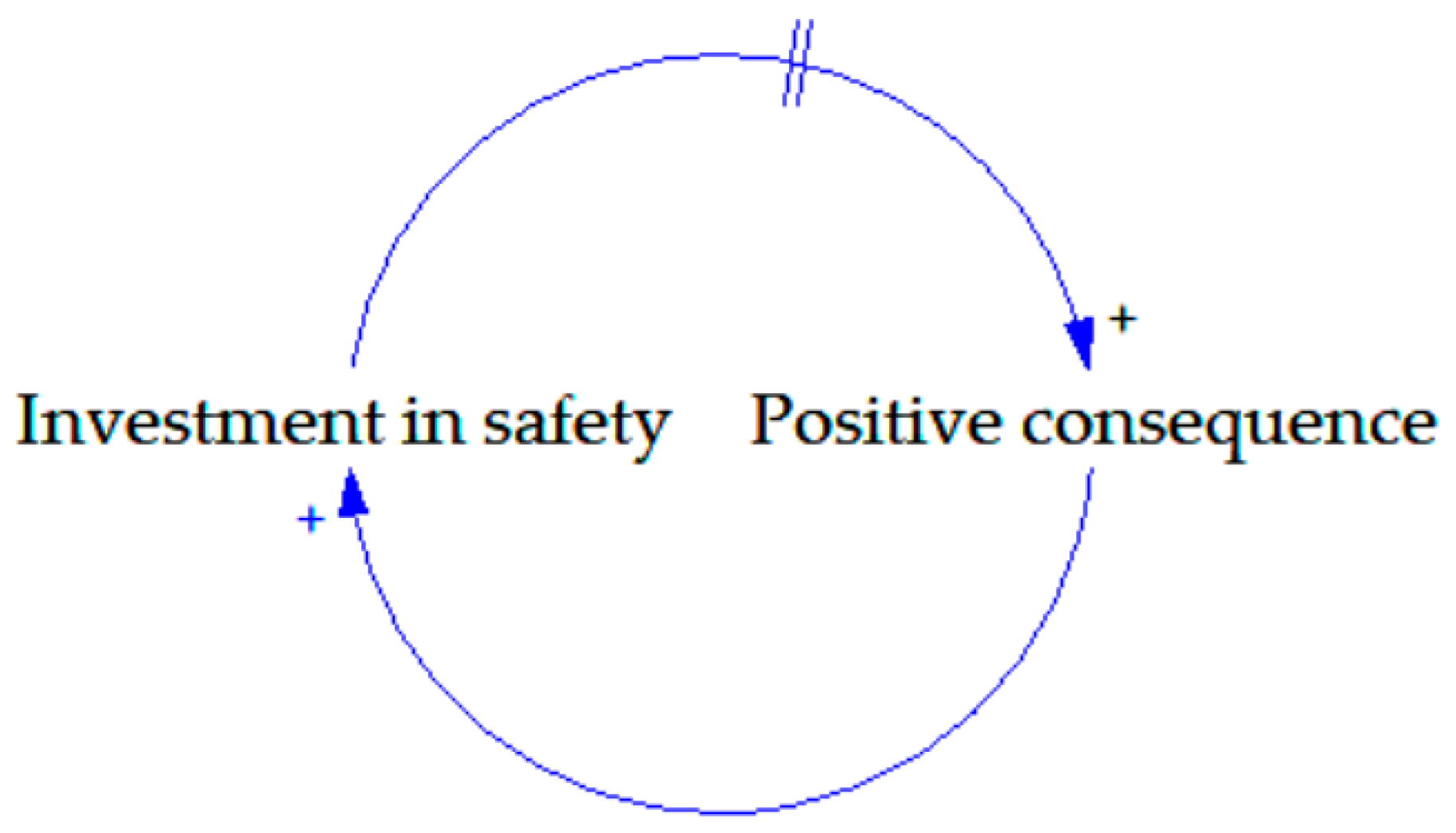
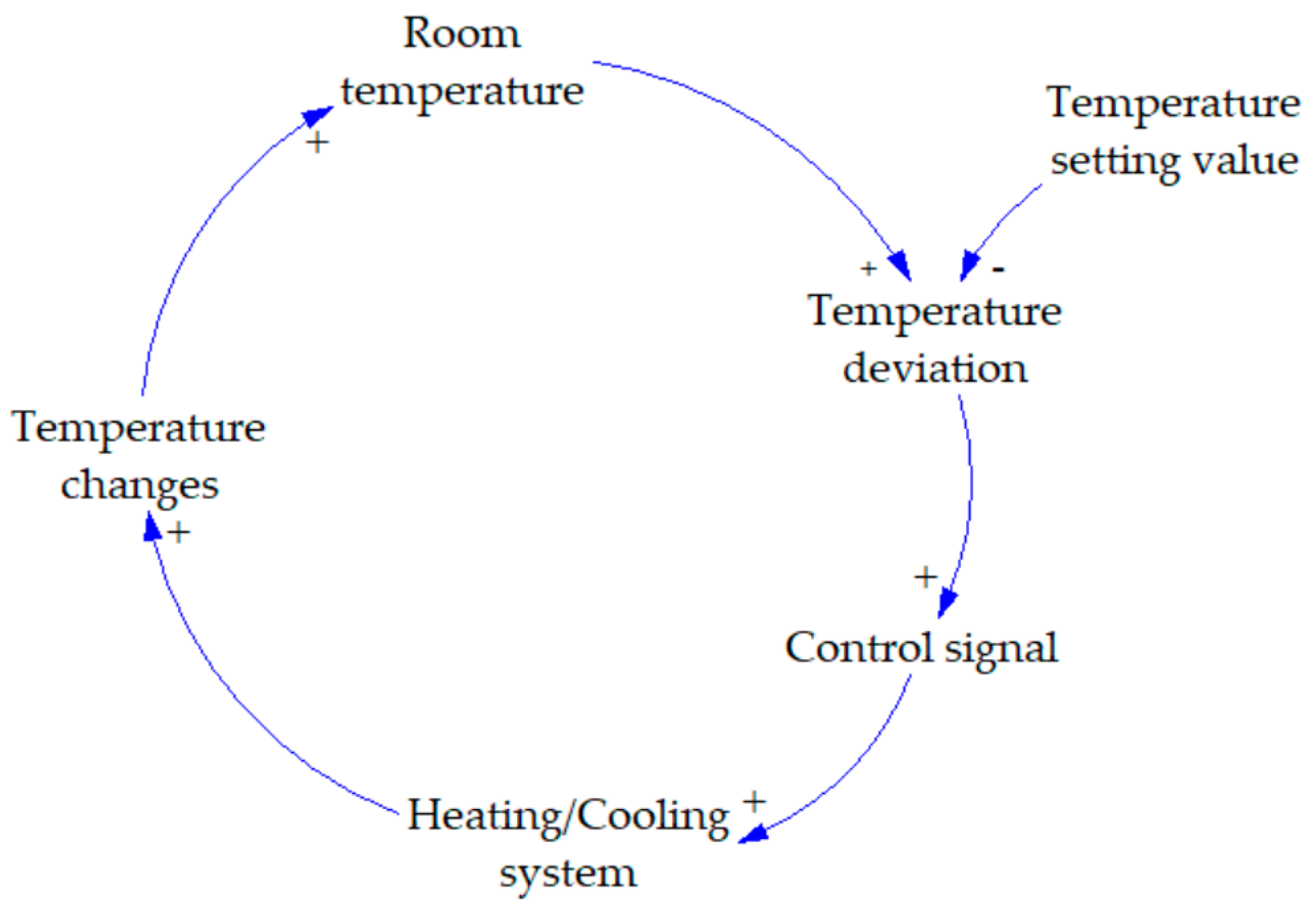
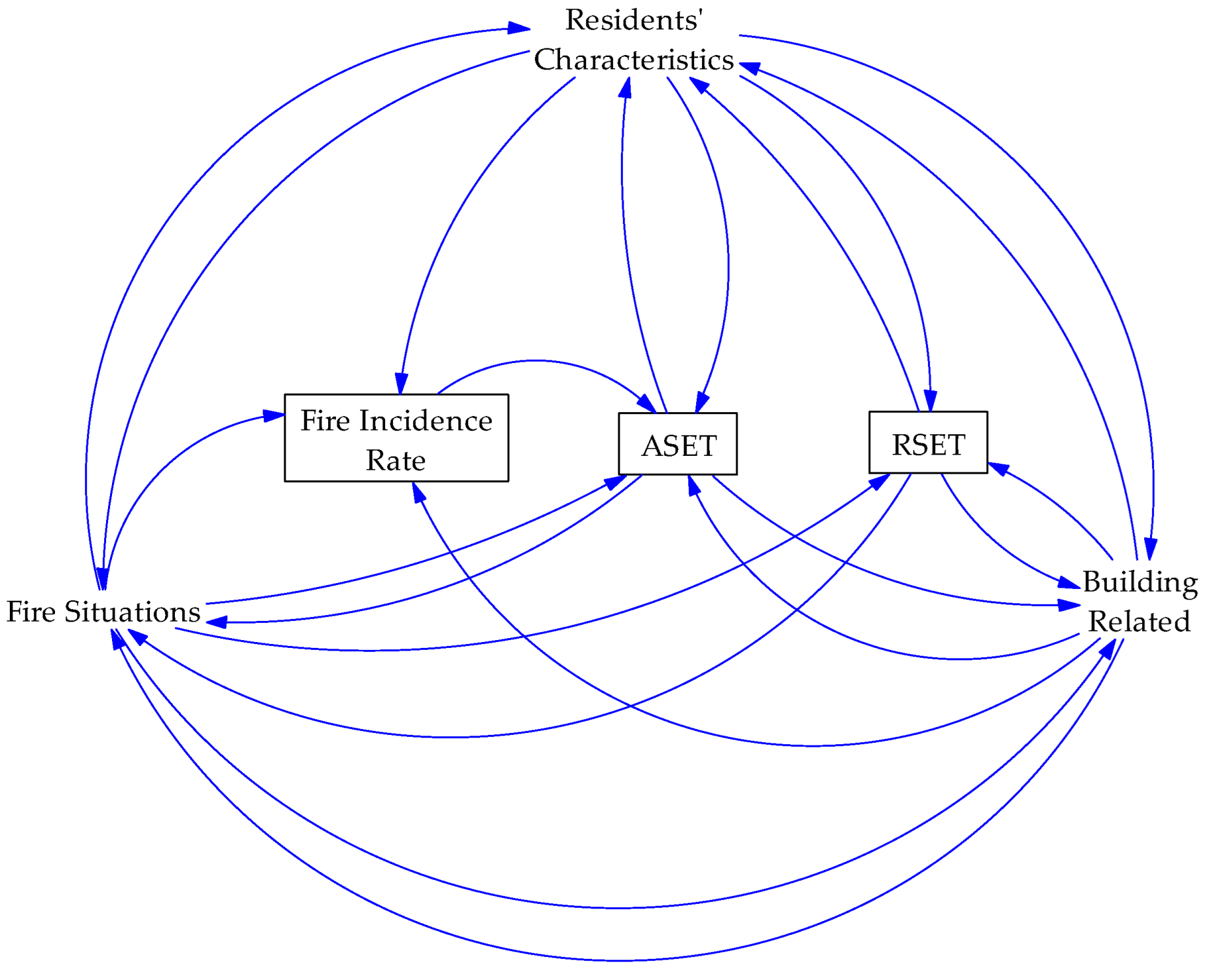
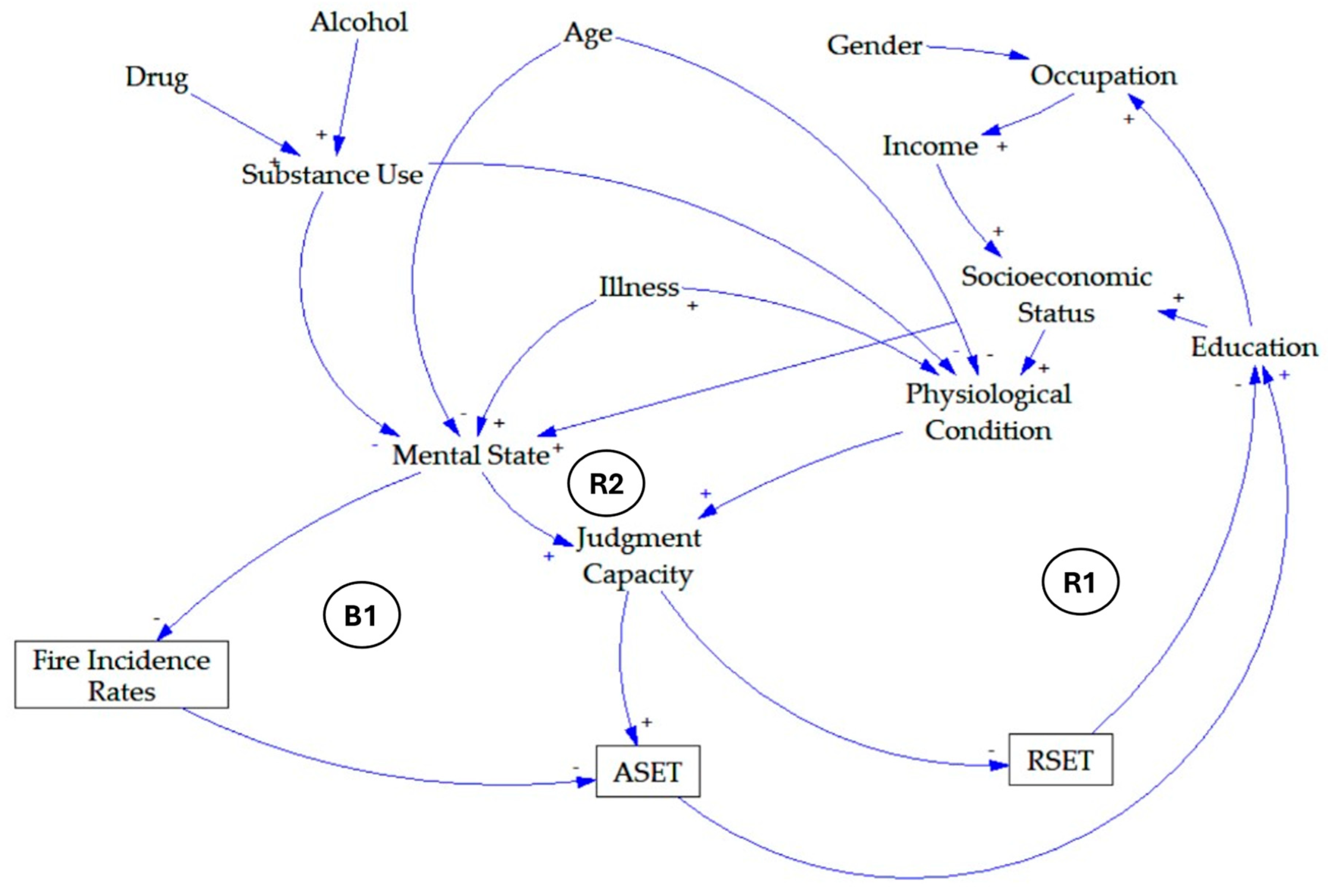
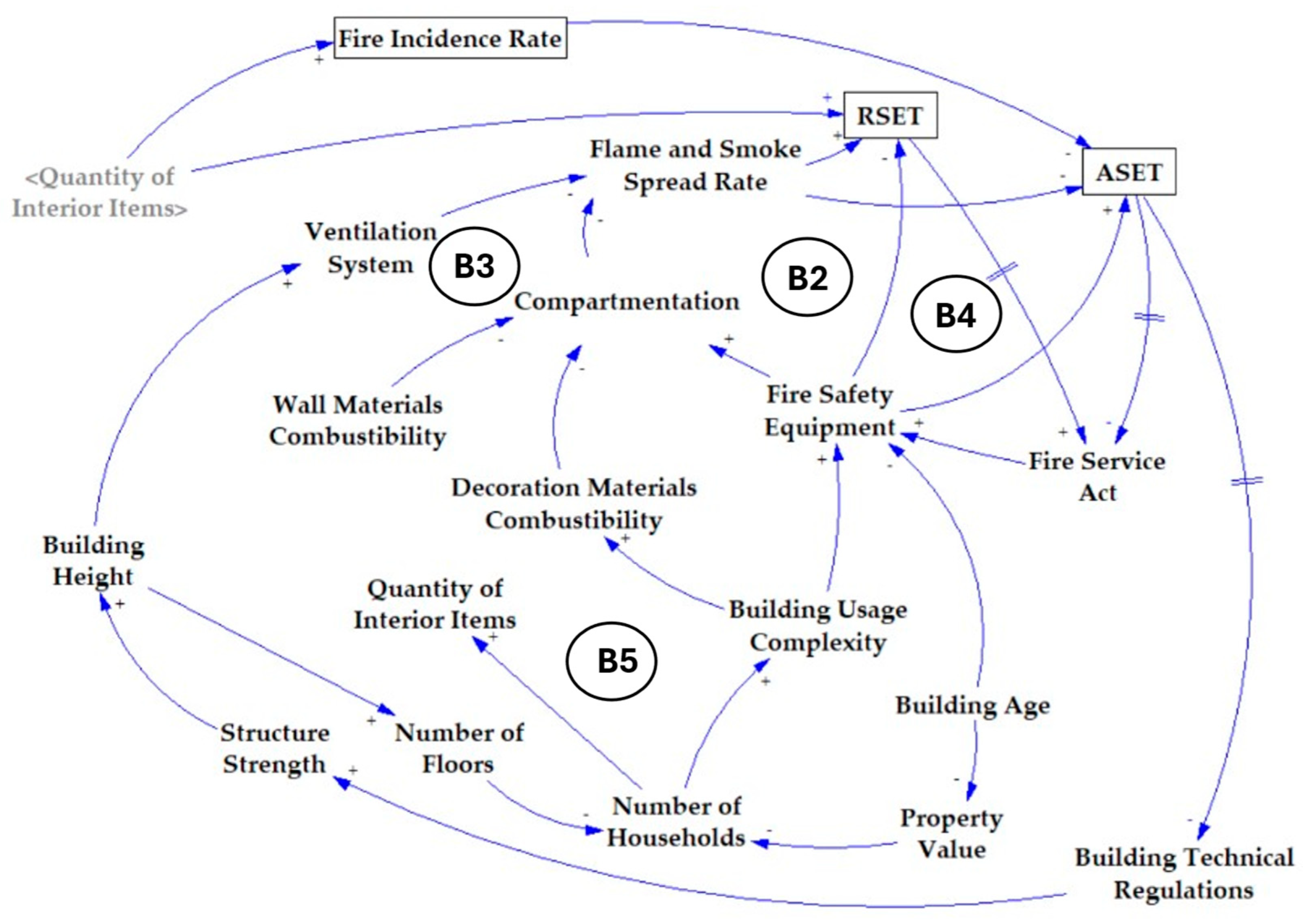
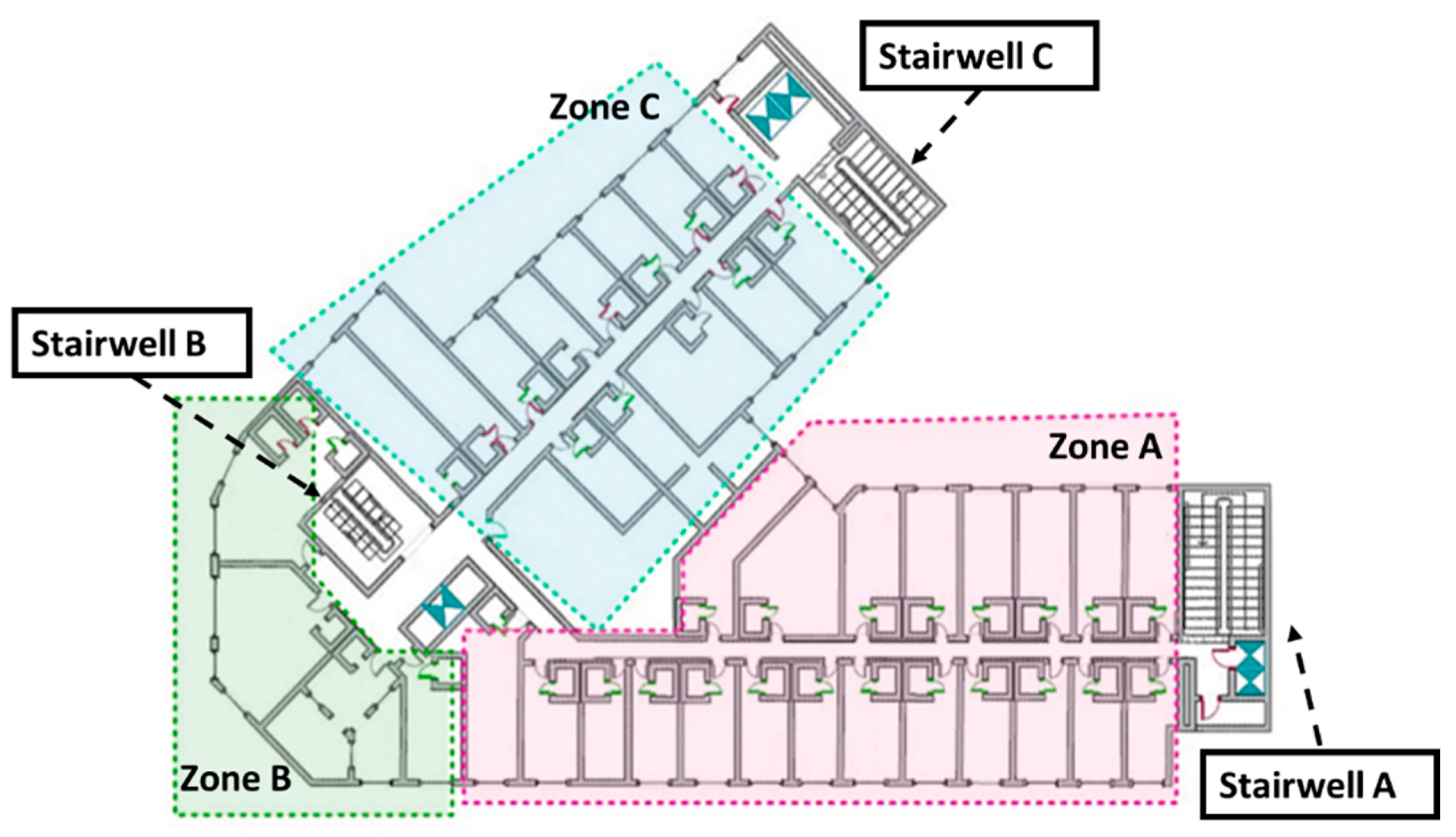

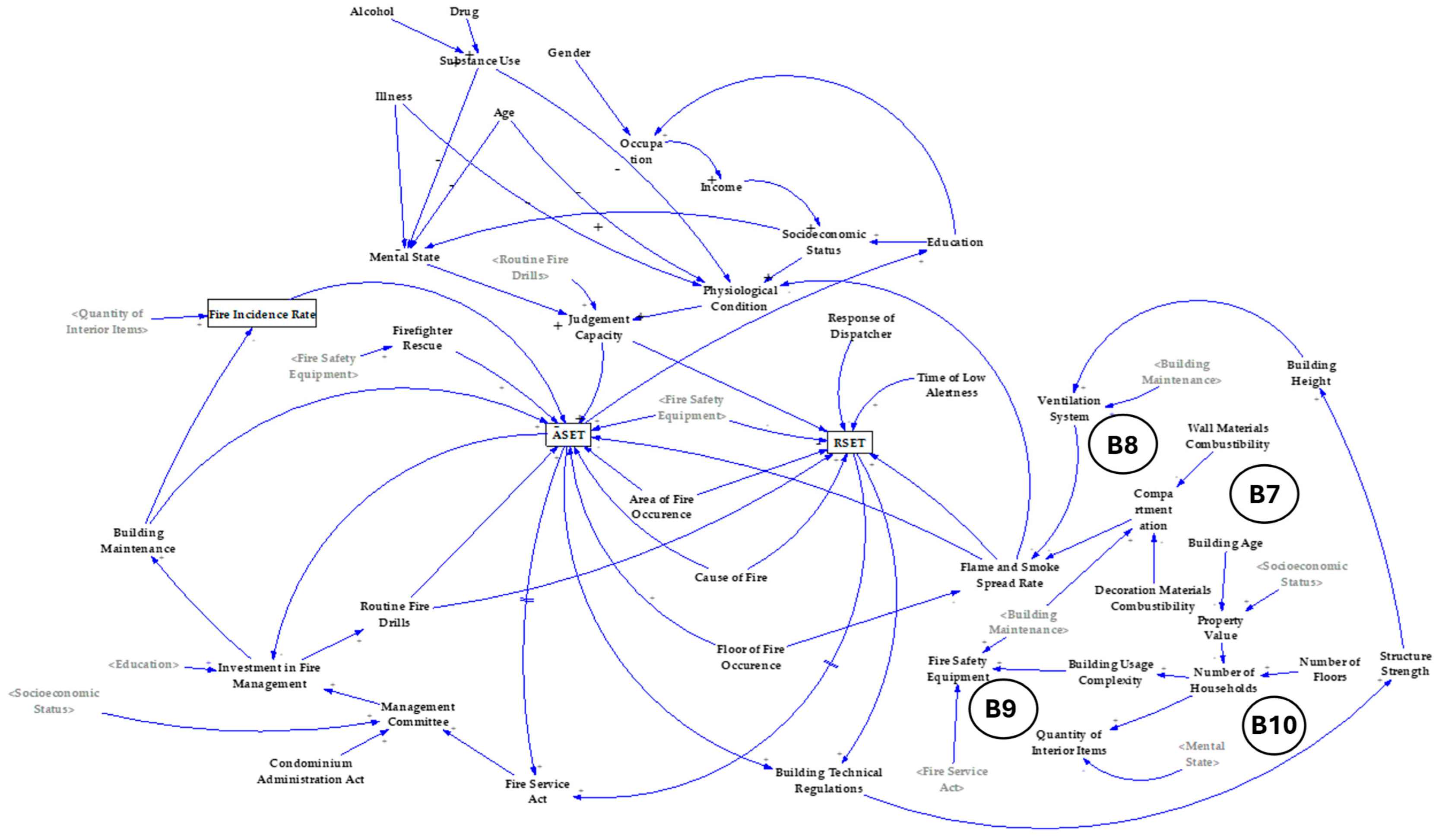

| Floor | Original Legal Use Type (with the Permit by the Kaohsiung Government) | Actual Use Type Before the Fire |
|---|---|---|
| 12F | Restaurant | Vacant (not for business or residential use) |
| 11F | Office | Divided into suites, the empty house was uninherited and was illegally occupied after old veterans passed away |
| 10F | ||
| 9F | ||
| 8F | ||
| 7F | ||
| 6F | Movie theater and settlement place of the theater owner | Settlement place of the theater owner |
| 5F | Movie theater | Vacant (not for business or residential use) |
| 4F | Shopping mall | |
| 3F | Shopping mall | |
| 2F | Shopping mall | |
| 1F | Shopping mall | An electric appliance store, antique tea set store; some stores closed and vacant; some wooden compartment-type stores |
| B1F | Shopping mall | Vacant (not for business or residential use) |
| Group | Critical Factors | Impacts | Reference |
|---|---|---|---|
| Residents’ Characteristics | Gender | Judgment Capacity of Residents | [4,7,8,9,10,11,12,13,14,15,23,25,26,27,28,29,30,31,32,33,34,35,36,37,38,39,40,41,42,43,44,45,46,47,48,49] |
| Income | |||
| Age | |||
| Education | |||
| Socioeconomic Status | |||
| Mental State | |||
| Physiological Condition | |||
| Substance | |||
| Occupation | |||
| Illness | |||
| Building-Related | Compartmentation | Flame and Smoke Spread Rate | |
| Fire Safety Equipment | |||
| Fire Service Act | |||
| Building Technical Regulations | |||
| Property Value | |||
| Building’s Age | |||
| Number of Households | |||
| Number of Floors | |||
| Structure Strength | |||
| Building Height | |||
| Wall Material Combustibility | |||
| Ventilation System | |||
| Decoration Materials Combustibility | |||
| Quantity of Interior Items | |||
| Building Usage Complexity | |||
| Fire Situation | Condominium Administration Act | Behavioral Responses of Residents | |
| Fire Service Act | |||
| Management Committee | |||
| Investment in Fire Management | |||
| Building Maintenance | |||
| Area of Fire Occurrence | |||
| Cause of Fire | |||
| Routine Fire Drills | |||
| Floor of Fire Occurrence | |||
| Time of Low Alertness | |||
| Firefighter Rescue | |||
| Response of Dispatcher |
| Floor | Death Toll | Male | Female | Actual Use |
|---|---|---|---|---|
| 12F | Vacant | |||
| 11F | 7 | 3 | 4 | Suites |
| 10F | 9 | 6 | 3 | Suites |
| 9F | 6 | 4 | 2 | Suites |
| 8F | 10 | 8 | 2 | Suites |
| 7F | 11 | 9 | 2 | Suites |
| 6F | 2 | 0 | 2 | Vacant |
| 5F | Vacant | |||
| 4F | Vacant | |||
| 3F | Vacant | |||
| 2F | Vacant | |||
| 1F | 1 | 1 | 0 | Mixed-use (store, living area, storage) |
| Total death toll | 46 | 31 | 15 | − |
| Floor | Compartmentation of the Stairwells |
|---|---|
| 12F | Incomplete (Stairwell A: ○; Stairwell B: ○; Stairwell C: ●) |
| 11F | Incomplete (Stairwell A: ●; Stairwell B: ●; Stairwell C: ●) |
| 10F | Incomplete (Stairwell A: ⊙; Stairwell B: ⊙; Stairwell C: ⊙) |
| 9F | Incomplete (Stairwell A: ⊙; Stairwell B: ⊙; Stairwell C: ⊙) |
| 8F | Incomplete (Stairwell A: ⊙; Stairwell B: ●; Stairwell C: ●) |
| 7F | Incomplete (Stairwell A: ●; Stairwell B: ●; Stairwell C: ●) |
| 6F | Incomplete (Stairwell A: ○; Stairwell B: ⊙; Stairwell C: ○) |
| 5F | Incomplete (Stairwell A: ⊙; Stairwell B: ⊙; Stairwell C: ⊙) |
| 4F | Incomplete (Stairwell A: ⊙; Stairwell B: ●; Stairwell C: ●) |
| 3F | Incomplete (Stairwell A: ⊙; Stairwell B: ○; Stairwell C: ○) |
| 2F | Incomplete (Stairwell A: ●; Stairwell B: ●; Stairwell C: ⊙) |
| 1F | Incomplete (Stairwell A: ●; Stairwell B: ●; Stairwell C: ●) |
Disclaimer/Publisher’s Note: The statements, opinions and data contained in all publications are solely those of the individual author(s) and contributor(s) and not of MDPI and/or the editor(s). MDPI and/or the editor(s) disclaim responsibility for any injury to people or property resulting from any ideas, methods, instructions or products referred to in the content. |
© 2025 by the authors. Licensee MDPI, Basel, Switzerland. This article is an open access article distributed under the terms and conditions of the Creative Commons Attribution (CC BY) license (https://creativecommons.org/licenses/by/4.0/).
Share and Cite
Juan, W.-Y.; Chen, W.-S.; Wu, C.-L. Applying Systems Thinking Concepts to Major Casualty Fires: Lessons Learned from Taiwan. Fire 2025, 8, 208. https://doi.org/10.3390/fire8060208
Juan W-Y, Chen W-S, Wu C-L. Applying Systems Thinking Concepts to Major Casualty Fires: Lessons Learned from Taiwan. Fire. 2025; 8(6):208. https://doi.org/10.3390/fire8060208
Chicago/Turabian StyleJuan, Wen-Yen, Wei-Sheng Chen, and Chia-Lung Wu. 2025. "Applying Systems Thinking Concepts to Major Casualty Fires: Lessons Learned from Taiwan" Fire 8, no. 6: 208. https://doi.org/10.3390/fire8060208
APA StyleJuan, W.-Y., Chen, W.-S., & Wu, C.-L. (2025). Applying Systems Thinking Concepts to Major Casualty Fires: Lessons Learned from Taiwan. Fire, 8(6), 208. https://doi.org/10.3390/fire8060208







